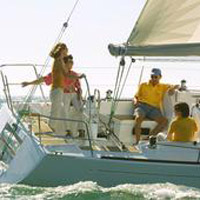Boating Lifestyle
Boating Lifestyle
There is so much to love, and learn, about boating. That's why we created this library of articles, videos and blog posts to help you throughout your adventures.
Your First Sail
 They say you always remember your first love. You always remember your first sail, too. What will yours be like? Here’s what happens during a typical sail.
They say you always remember your first love. You always remember your first sail, too. What will yours be like? Here’s what happens during a typical sail.
The first time you go out on the water in a sailboat will be a memorable experience like no other. This will give you an idea of what you can expect on your inaugural voyage.
Chances are you will be starting from a marina. Once you have motored clear of the docks and are in sailing waters, the mainsail will be the first thing to go up. First steer the boat so it is facing the direction where the wind is coming from. It’ll go up easily almost all the way, but the last foot or two will take some pulling and you’ll find that this job is much easier with a winch handle. The boom—the horizontal bar attached to the mast that holds the foot, or bottom, of the mainsail—may be swinging side-to-side as the sail “luffs,” or flaps about like a flag. That’s OK; just keep your head out of the way. If it’s windy, it’ll be a little bit noisy, too. To sail properly, make sure the ‘outhaul’ that pulls the foot of the sail along the boom, and that the ‘boomvang’ which are the lines that pull the boom down towards the cabin of the boat, are both tightened and secured.
The jib, the triangular sail ahead of the mast, goes up next, but it’s easier to hoist than the mainsail. It will flap around, too, but doesn’t have anything hard attached to it.
Once the sails are up and secured, the skipper (helmsman) will steer the boat off the wind and then the sheets of both sails will need to be pulled in so the sails fill with air. If the wind is brisk, the boat will “heel” (lean) over a bit. The skipper and crew all work together as a team to maintain their course and to sail as fast and efficiently as possible by adjusting their course and sails.
When you want to change direction, the skipper calls “ready to come about” and one crewperson gets ready to release the jib sheet while another crewperson gets ready to pull the jib sheet on the opposite side of the boat. It’s also a good idea to have someone watching the mainsail to ensure it moves across the boat in a controlled manner when changing directions. When everyone is ready the skipper calls “coming about” and turns the boat toward where the wind is coming from and beyond. When this is happening, the jib sheet is released where it was tied and is quickly pulled in on the opposite side and secured so it fills with air again.
As you continue to steer, trim, and practice maneouvers things will quickly become familiar to you and the techniques more natural. When it’s time to sail back to the marina, you’ll wish you could stay out longer, and will look forward to your next lesson. You’re on your way to becoming a sailor.
Just remember to learn the “Rules of the Road” on the water, like Right-of-Way and channel markers and when in doubt stay clear of any oncoming boats.


